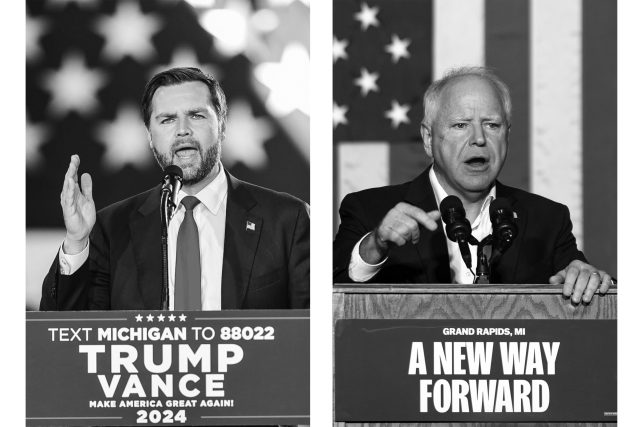[ad_1]
Tuesday’s vice presidential debate between Minnesota Gov. Tim Walz (D) and Sen. JD Vance, R-Ohio, came amid one of the closest presidential races in modern American history. In swing states, Vice President Kamala Harris and former President Donald Trump are essentially tied in the polls, indicating that even a slight change of popular support could decide the election. Three of those seven swing states are in the Midwest, where both vice presidential candidates hail from — and during the debate, it showed.
Unlike the loud, often mean-spirited debates we’ve become accustomed to over the past eight years, the meeting between Vance and Walz was surprisingly cordial, even conciliatory. “Midwestern nice” dictated the decorum, and Midwestern issues defined the discussion. The candidates kept interruptions to a minimum and engaged in good faith dialogue over pressing issues such as job loss due to automation and globalization, high prices devastating small towns and immigration.
The candidates found common ground in the problems their states — and most of the country — share. Consequently, “I agree” was one of the most common phrases throughout the night. That said, the two candidates offered very different solutions to those problems — solutions informed by two very different understandings of what the Midwest is and what its voters will respond to. It is these two views of what the Midwest stands for that defined the debate.
On stage, Vance came off as largely distrustful of the establishment and its policies. Discussing the country’s economic woes, he suggested that “economists attack Donald Trump’s plans, and they have Ph.D.s, but they don’t have common sense.” The senator cited “common sense” on several occasions — which, in this context, sounded a lot more like anti-intellectualism.
Walz mocked him for it. “Economists don’t, can’t be trusted. Science can’t be trusted. National security folks can’t be trusted,” he said. “My pro tip of the day is this: If you need heart surgery, listen to the people at the Mayo Clinic in Rochester, Minn., not Donald Trump.” This was a good moment for the governor and a sobering moment for much of the audience that, despite how appealing Vance’s argument of “common sense” may seem, his suspicion of experts is misleading and unfounded.
Vance also brushed aside any fears about the climate crisis. He largely brushed off the effects of global warming, and pledged to increase oil drilling if he and Trump win in November. Walz, on the other hand, addressed the ways in which climate change is affecting farmers, including massive fluctuations in precipitation. He also described new green energy investments that would create jobs, hailing solar and wind farms as the path forward.
On immigration, Vance falsely accused undocumented immigrants of increasing housing prices, crime rates and overdoses in the U.S. Again, Walz shot back, criticizing Trump for killing a bipartisan border security bill. “Democrats and Republicans worked on this piece of legislation. The Border Patrol said, ‘This is what we need in here.’ These are the experts. And the Chamber of Commerce in the Wall Street Journal said, ‘Pass this thing,’” he said. “But as soon as it was getting ready to pass and actually tackle this Donald Trump said ‘No.’”
This divide over who should be trusted — the experts or Trump — manifested itself in almost every exchange of the night. It also made the Republican ticket appear revisionist. Vance consistently tried to rewrite parts of the Trump presidency. In a spar over the Affordable Care Act, the senator falsely claimed that Trump saved the health care plan from being repealed. This was a blatantly inaccurate statement. The former president campaigned on ending the ACA in 2016, and he routinely attempted to weaken the legislation during his four years in the Oval Office. Walz, for his part, reaffirmed Harris’ dedication to preserving and strengthening the act.
Walz won on most of the issues — and he embodied true Midwestern values more than Vance, despite Vance’s deliberate, populist appeals. That said, while Walz’s vision for the region was more compelling than Vance’s, he was far worse at communicating it.
Repackaging Trumpism into something palatable is no easy feat, but Vance did it as well as he could have. The former president’s viral gaffes in his Sept. 10 debate with Vice President Harris — such as his rant about the size of his rallies, his assurance of “concepts of a plan” for health care and his baseless allegations that Haitian immigrants are “eating the cats and dogs,” — seemingly dug an inescapable hole for the GOP ticket.
Yet, Vance took the failing Trump campaign and revitalized its bid to undecided voters. Faced with the herculean task of reframing eight years of presidential politics, Vance exceeded expectations in his depiction of Trump as a pro-labor, pro-health care moderate. Vance played the part of the Rust Belt warrior, and he did it well.
Even so, his draw seemed entirely based on bitterness. Vance’s plan for the future of the Midwest — and what his victory here would mean — would create a region unable to look forward or overcome his bigoted attitudes. Walz cast himself as the small-town coach and union man. He wasn’t wrong when he said he was “a knucklehead at times”; however, the statement demonstrated humility, which is far more aligned with Midwestern values than the slick talking of his opponent.
Anti-intellectualism, antielitism and anti-immigration sentiments are not, and should not come to be, what define us. The Midwest is about treating one’s neighbor with respect and being resilient, not resentful, toward the adversity that faces us. In 28 days, Midwesterners will not only be voting for a president, but also for what their home stands for. Instead of Vance’s vision of suspicion, contempt and hostility, choose trust, respect and hospitality.
This editorial represents the opinion of The Michigan Daily’s Editorial Board. If you are interested in submitting an Op-Ed or Letter to the Editor, please send your submission to tothedaily@michigandaily.com.
Related articles
[ad_2]
Source link











